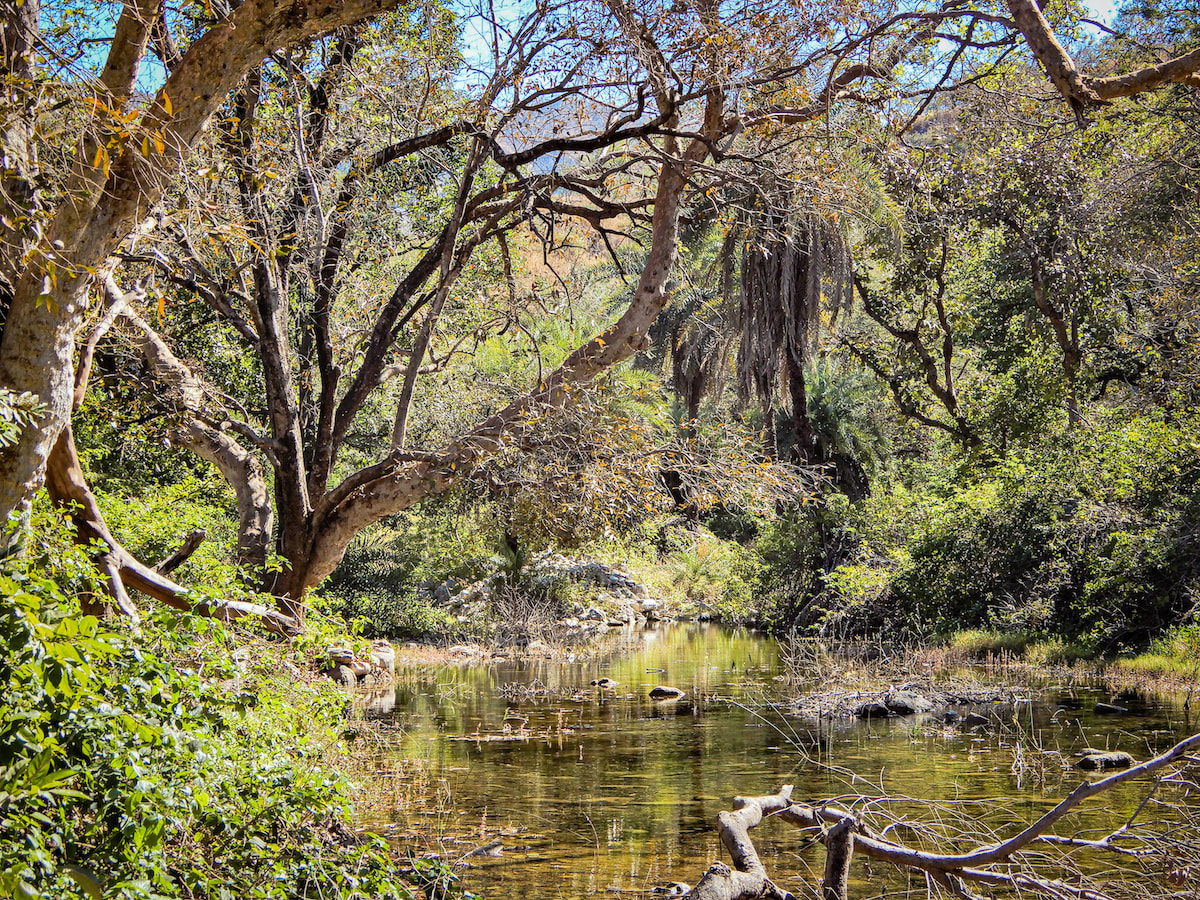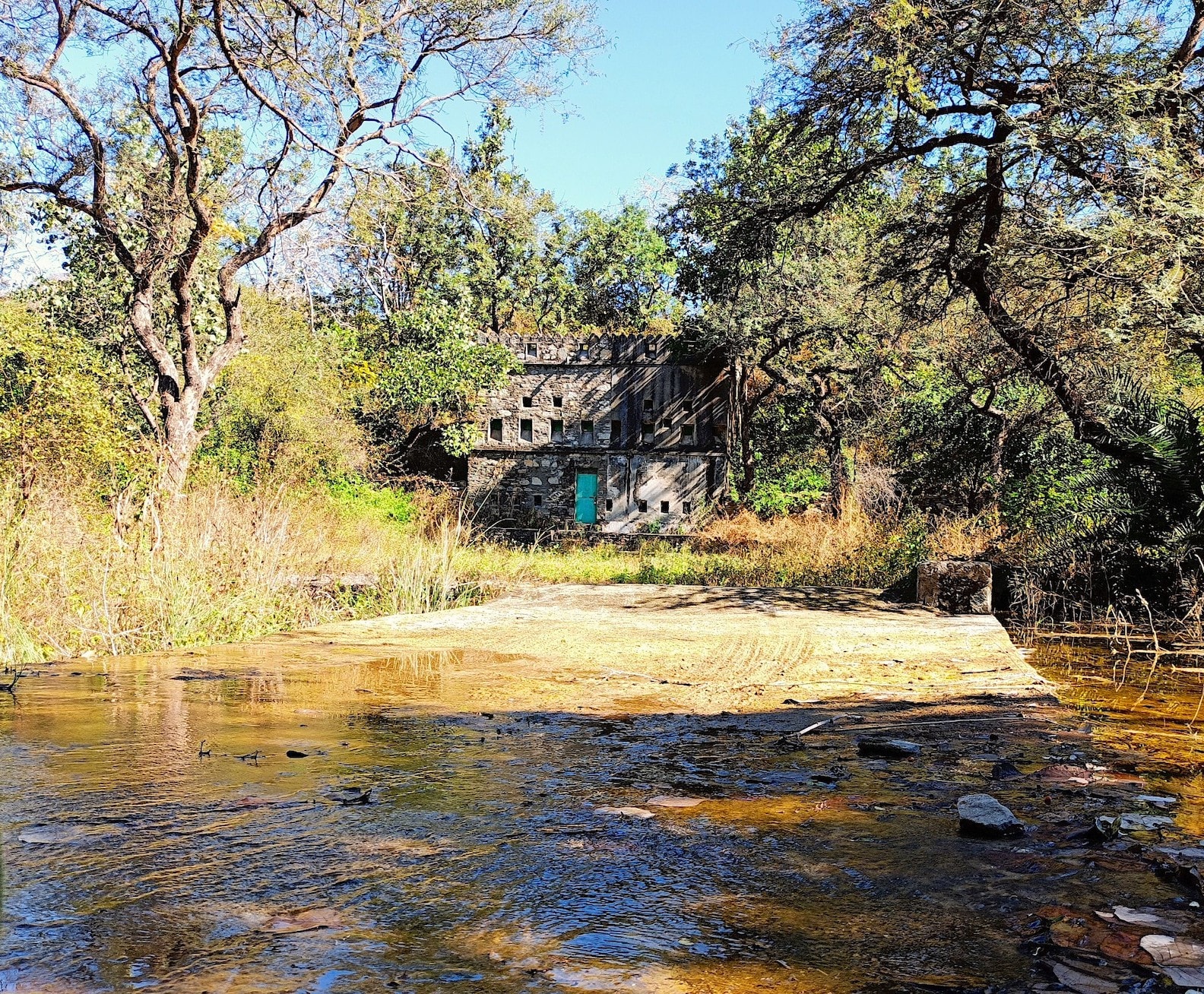Quietude descends as I set foot inside Rajasthan’s Kumbhalgarh Wildlife Sanctuary. Later, I find that the silence of the forest is even more pervasive in the adjacent, less-frequented Todgarh-Raoli Wildife Sanctuary. That’s not to say that these two sanctuaries located in central Rajasthan are bereft of wildlife. Wild animals leave tell-tale signs in the form of pugmarks and scat, indicating their presence. However, unlike the more popular parks in the state like Ranthambore, they are not habituated to tourists.
A sambar honks from a thicket, teasing us to spot it. Numerous mammals live in these two sanctuaries, located along the ranges of the oldest fold mountains in the world, the Aravallis. Those who are patient and observant are rewarded with sightings: a hyena bolting back to its cave; a sloth bear foraging for ber fruits by the road side; a leopard lounging on a rocky outcrop.
Soaking in the vast landscape, I can’t get rid of the feeling that I’m stuck in a time-warp. From some vantage points in the sanctuaries, the hills roll on for as far as the eye can see. From a distance, the foliage of trees such as the salar (Boswellia serrata), dhavda (Anogeissus pendula), dhau (Anogeissus latifolia) seem like patches of curly hair on a balding head.
The sky wears a riot of colours at dusk. Blue, yellow, orange, pink…the lightshow lasts until night falls. And even after we exit, we continue to revel in the geological marvelousness of the landscape, and the realisation that irrespective of the wildlife we saw, or didn’t see, the experience was more magnificent than expected.

The charm of exploring Kumbhalgarh (pictured here) and Todgarh-Raoli sanctuaries is in the fact that they are relatively off the beaten track for the wildlife tourist. Photo: Anirudh Nair
Cover: The Thandi Beri Forest rest house in Kumbhalgarh overlooks a lake formed by an anicut, which serves nearby villages. Staying at the forest rest houses inside the sanctuary allows visitors to experience the jungle up close and personal. Cover photo: Anirudh Nair
EXPLORE
Dudhaleshwar Temple: Located in the middle of the Todgarh-Raoli Wildlife Sanctuary, the temple complex houses a perennial source of spring water. Caretakers say that the place is frequented by leopards and sloth bears at night.
Katar Ghati: An engineering marvel, this four-kilometre road on the way to Dudhaleshwar Temple from Todgarh was constructed in the form of a serpent by British engineers.
Ghoram Ghat: Around 12 km from Todgarh, a railway track between Kamlighat and Fulad station offers a scenic view of waterfalls, tunnels, and bridges.
Bheelberi: At 55 m, Bheelberi is one of the highest waterfalls in Rajasthan. Indian vultures can be seen roosting on the rock cliffs near the waterfall.
Kumbhalgarh Fort: A UNESCO World Heritage Site, Kumbhalgarh Fort is an architectural masterpiece showcasing the splendour of Rajput fort design. According to Guinness World Records, the walls of the fort, located within the sanctuary, are the longest continuous wall in the world around a fort/castle.
Parshuram-Mahadev track: Chances of sighting sloth bears are high along this route.
Rana Kakar: The Badal Forest Rest House is located on this peak of the Aravalli ranges. It offers a spectacular panoramic view of the mountain range.
The leopard (top) is the top predator of this landscape. The rocky outcrops that are characteristic of this landscape provide the big cat with perfect hideouts and vantage points to stalk prey such as nilgai (above). Photo: Bheru Bishnoi, Video: Rohit Kumar/Ecotone Adventures
Safaris
Jeep (Gypsy) safaris can be undertaken only in Kumbhalgarh Wildlife Sanctuary, all through the year except during the monsoon months (July, August and September), when the sanctuary is closed to tourists. Vehicles can be hired from the entrance gates at Ranakpur (Sadri range), Ghanerao (Desuri range range) or Aret (Kumbhalgarh range). Aret to Thandi Beri, Ranakpur to Muchhal Mahavir and Muchhal Mahavir to Joba are the popular safari tracks. Private tour operators such as Evergreen Wildlife Safari can help organise safaris. Visitors can also undertake guided walking tours in Kumbhalgarh.
Travel in Toadgarh is not as easy. Those wishing to undertake a safari here must inform the forest department well in advance so that the necessary arrangements can be made. The DCFs of Rajsamand, Ajmer or Pali can be contacted for permission.
Cost: It costs Rs 2,250 to hire a Gypsy safari vehicle. Plus there is an entry fee of Rs 65 (for Indian)/Rs 365 (foreigners) per person and an eco-guide fee of Rs 300.
Hours: Counters are open from 6 am to 9 am and 3 pm to 4.30 pm. Safari timings are 6-11 am and 3-6.30 pm.
Watch out for
Mammals: Leopards, sloth bears, hyenas, honey badgers, nilgai, sambar, wild boar, wolves, jackals, small Indian and palm civets, jungle cats, and rusty-spotted cats.
Birds: Crested serpent eagles, changeable hawk eagles, oriental honey buzzards, black-shouldered kites, plum-headed and rose-ringed parakeets, golden orioles, white-bellied drongos, grey jungle fowls, red spurfowls, paradise flycatchers.
Reptiles: Indian rock pythons, Indian cobras, crocodiles, star tortoises, monitor lizards, checkered keelbacks, common bronze-back tree snakes.
(Left) Crocodiles are seen basking leisurely alongside cattle around the lake near Thandi Beri Forest Rest House around noon. During the monsoon, forest officials often capture young crocodiles that are pushed over the anicut from nearby villages. (Right) They also receive the occasional call to capture rock pythons and release them back into the sanctuary. These snakes stray outside the sanctuary into human-inhabited areas. Photos: Bheru Bishnoi
Getting there
By Rail: Beawar (around 76 km) and Ajmer (around 120 km) are the nearest railway heads to the Todgarh-Raoli Wildlife Sanctuary. Falna (around 80 km) is the nearest railway station to reach Kumbhalgarh Wildlife Sanctuary. Private taxis can be hired from these stations to the entrance of the sanctuaries.
By Road: Todgarh-Raoli Wildlife Sanctuary is around 25 km from Jassa Khera on NH-8 Delhi-Udaipur Highway. Take NH76 from Udaipur city (around 65 km) to reach Kumbhalgarh Wildlife Sanctuary. One can opt for buses and private taxis as well. State transport buses are also available from Rajsamand (around 48 km), Jodhpur (around 207 km) and Jaipur (around 345 km). The two sanctuaries are close to each other.
By Air: Udaipur (around 84 km) is the closest airport to both sanctuaries.
Seasons
October to March is when the weather is pleasant. Chances of sighting wildlife increases during the summer months (April-June ) but tourists must contend with the temperature, which can rise to over 40 degree Celsius.
STAY
Rest Houses
Tourists can stay within the sanctuaries or outside. Staying at the government forest rest houses inside the sanctuaries offers an immersive jungle experience. Listening to jackals howling into the night and gazing at a sky full of stars adds to the experience.
Government forest rest houses are located at Raoli, Dudhaleshwar, Bagdi and Bheelberi in the Raoli-Todgarh Wildlife Sanctuary and at Diver, Sumer, Thandi Beri, Badal and in the Kumbhalgarh Wildlife Sanctuary. Rooms begin from Rs 800 per night. For bookings contact the District Forest Officers of Ajmer, Pali, Rajsamand or Udaipur.
Hotels
Mana Hotels, King’s Abode, Dera Kumbhalgarh, Maharani Bagh Orchard Retreat are some private hotel options near Kumbhalgarh. Hotel Shilpi in Ranakpur is operated by the Rajasthan Tourism Development Corporation. These hotels offer safaris into the park and bookings can be done online.

In some areas of the sanctuaries, historical shooting boxes or oudis, used by erstwhile rulers for hunting, are now used by forest officials as hideouts to count animals during the annual wildlife census. This one was seen on the trek to Thandi Beri. Photo: Rohit Kumar
Tips:
• While on safari wear dull-coloured clothes that blend in with the forest. Full-sleeve shirts and thick pants are advisable if you intend to walk through the rugged terrain.
• Carry sweater and jacket if visiting during the winter months.
• Good trekking shoes will serve you well.
• Don’t wear perfume or deodorant.